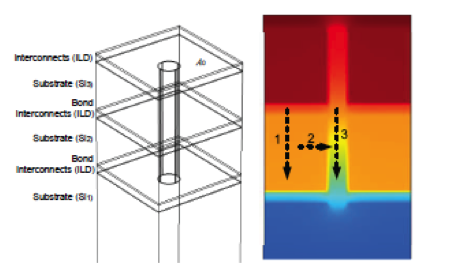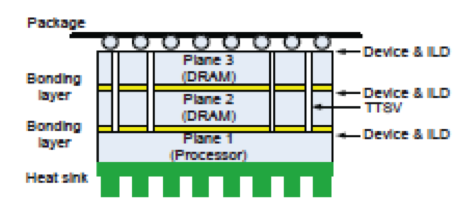***Archived: This is a past project, it is not on offer at the moment!***
Project Description:
Three-dimensional (3-D) or vertical integration is expected to be the “next best thing” in integrated circuits. Some of the important challenges related to this type of circuits include the efficient power management. This situation is due to the smaller footprint and the multi-layer structure of the system that can result in pronounced thermal issues. Accurately analyzing the thermal behavior of these circuits will, therefore, be necessary such that the envisioned performance benefits are obtained while guaranteeing the reliable and robust operation of the circuit throughout the specified lifetime.
Heat in 3-D circuit is primarily conducted in the vertical direction through the different materials of the stack to the heat sink. Primary heat conduits in this process are the TSVs – the short vertical interconnects – connecting adjacent physical layers (see Fig. 1). Our group has recently provided a closed form model that describes the steady-state thermal behavior of the TSVs with high precision. Based on this model, this project will focus on the transient thermal characteristics of the TSVs in 3-D circuits. The heat generated (not just transferred) within the TSVs will also be investigated and modeled.
 |
 |
|
|
Fig.1. Partial segment of a 3-D IC, where a stack of thermal TSVs and the primary heat transfer paths are illustrated. |
Fig.2. An example of a 3-D system including a processor layer and two DRAM layers with embedded thermal TSVs. |
The student is required to develop accurate thermal models (adapting the existing ones, as well) that describe the heat transfer through the TSVs for different scenarios and technologies for 3-D systems (see Fig. 2). Emphasis will be placed on the development of closed form models. The project will include the following steps: 1) a short literature overview (with deep understanding of our existing model), 2) simulations with a proper software package (available in the lab), and 3) development of a new model. Possible directions to extend this work will also be explored during the course of this project.
The desired qualifications for this project are:
- Previous experience with multi-physics analysis tools and/or tools employing FEM for modeling physical processes
- Some knowledge on modeling physical phenomena
The interested student will be guided by a PhD student and a post-doc. Please contact Dr. Vasilis Pavlidis ([email protected]) or Mr. Hu Xu ([email protected]) should you be interested in this project.
This project was supervised by Vasilis Pavlidis and Hu Xu.
***Archived: This is a past project, it is not on offer at the moment!***